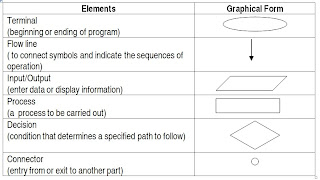
1. ANALYSIS PHASE
· The programmer will interview the client to find out what the client’s needs are.
· Identify input, processing, output and data component.
· Ask expert,refer to book and website.
· Meet with the system analyst and user.
For example, the client might be a school that wishes to set up a school registration program. So the school administrator might tell the programmer that they need to record students’ data such as name, date of birth, gender, class, parents’ names, address and contact numbers.
2. PROGRAM DESIGN PHASE
· The programmer will divide all program activities into program modules
· Create solution algorithm for each program modules
· Write an outline of the logic(pseudo code) of the program.
· Design a flow chart.
· Design user interface
Pseudo code

Flow Chart


3. CODING PHASE
· Translating the algorithm into programming language.(usually on paper)
· After finishing the coding process, the programmer will type the programming language code into the computer.(eg.Pascal,C++ and Visual Basic)
· Is to ensure the program runs correctly without any syntax or logic errors.
· If errors are uncovered during testing, the programmer will proceed to debugging.
· Debugging involves tracing the source of errors in the program and making the necessary corrections.
· Documentation refers to the written material generated throughout all the phases of program development.
· Thus documentation includes the detailed problem definition, the program plan (flow chart or pseudo code), comments within the source program and testing procedures.
· A detailed description of the program, clear layouts of input and output records and a program listing.

No comments:
Post a Comment
Note: Only a member of this blog may post a comment.